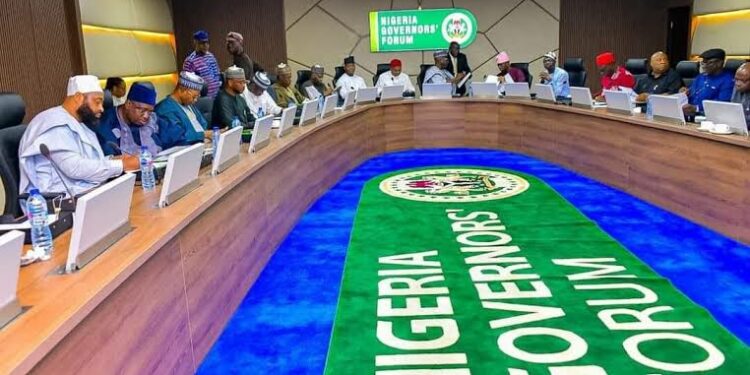According to The PUNCH, the sub-nationals are currently facing a tremendous financial hardship as a result of debt payment expenditures that accounted for 80.7% of their Internally Generated Revenue for the first half of 2024.
The governors were compelled by the terrible circumstances to take out an N446.29 billion loan in the same time frame, even though their statutory allocation from the Federation Account had increased by 40%.
The most recent information comes from an examination of data that a news correspondent gathered by utilising Open Nigerian States and the budget implementation reports found on each state’s website. This website, supported by BudgIT, acts as a database for public budget information.
The performance report is created on a quarterly basis and released four weeks after the conclusion of each quarter.
This significant burden highlights a crucial problem with fiscal management since states are diverting most of their money, which they could be using for development projects and other vital public services, to pay off debt.
It also exposes the extreme limitations state governments confront in trying to meet the needs of their citizens while also managing the debt loads left over from past administrations.
Nigerians had anticipated that state governors would have more than enough money to carry out their statutory duties after the central government boosted their statutory budget to 40%.
State governors received the most FAAC allotment in 2023 compared to the previous seven years. The removal of petrol subsidies and the present administration’s currency reforms were followed by an increase in FAAC allocations to the three tiers of government, particularly the states.
Income is said to have increased by 40% as a result of the reforms. According to experts, state governments shouldn’t have been as eager to borrow more money after the revenue gain.
Rather, a significant portion of the subnationals’ income is going towards loan repayment and further borrowing.
According to reports, the majority of the cash allocated by the Federal Accounts Allocation Committee to the states of Osun, Ondo, Kaduna, and Cross Rivers this year will go towards debt servicing.
This is due to the fact that these states currently have deficits of N10.94 billion, N27.72 billion, N15.83 billion, and N10.02 billion, respectively, after FAAC debt payment deductions.
It gets harder for states to achieve long-term economic stability and raise the standard of living for their citizens when such a substantial part of revenue is going into debt payment.
The governor of Kaduna State, Uba Sani, expressed his displeasure earlier this year over the massive debt load that was carried over from past administrations. He bemoaned the fact that this burden had prevented him from paying salaries on time and forced him to take out further loans in the final nine months of his tenure.
At a Town Hall Meeting held at the late Umaru Musa Yar’Adua Hall, the governor revealed this information. He said that his administration inherited a total of $587 million, N85 billion, and 115 contract liabilities.
“Despite the huge debt burden of $587m, N85bn, and 115 contractual liabilities sadly inherited from the previous administration, we remain resolute in steering Kaduna State towards progress and sustainable development. We have conducted a thorough assessment of our situation and are sharpening our focus accordingly,” the governor stated.
According to investigations, state governors had a difficult time boosting their own states’ economies since their predecessors left them with at least N2.1tn in domestic debt and $1.9bn in foreign debt.
This occurred as a result of 22 states spending a total of N251.79 billion between July 2023 and March 2024 to pay off debt taken on by previous governments.
Due to the extreme fluctuations in foreign exchange, the state governments of Ekiti, Cross River, and Ogun were also compelled to suggest a suspension of their $501 million international loan obligations.
FAAC denied the motion, although it was a part of their attempt to lessen the increased debt service obligations, which state representatives said had made it much more difficult for them to pay down their current debts.
Experts claim that there is limited space for investment in infrastructure, healthcare, education, and other critical areas that are essential for social welfare and economic progress due to the high costs of debt servicing.
Akwa-Ibom, Borno, Cross Rivers, Edo, Katsina, and Niger, on the other hand, used between 60 and 80 percent of their internally generated revenue to pay off debts, according to an examination of the budget implementation report.
Additionally, between 13 and 58 percent of the revenue from states like Abia, Anambra, Bayelsa, Delta, Ebonyi, Ekiti, Jigawa, Enugu, Kebbi, Kwara, Ondo, Osun Zamfara, and Oyo was used to pay off debt.
Nine states—Adamawa, Bauchi, Gombe, Imo, Kano, Kogi, Plateau, Taraba, and Yobe—saw more debt servicing costs than they brought in during that time.
At the time this report was submitted, information was unavailable for the states of Benue, Nasarawa, Ogun, Rivers, Sokoto, and Kaduna. Only Lagos State paid N201.49 billion in debt costs while registering an astounding IGR of N603.71 billion.
According to a state-by-state analysis, Abia State, led by Governor Alex Otti, paid N4.83 billion in debt service charges compared to N15.6 billion in income, or a ratio of 31%.
While Akwa-Ibom state paid N20.78 billion on debt servicing and received N31.74 billion in IGR, indicating a 65.4% ratio, Adamawa spent N14.48 billion on debt servicing and earned N5.75 billion, establishing a deficit of minus 252 percent.
Anambra used N4.8 billion to pay down its debt, but received N18.61 billion in IGR—a ratio of 25.9%. After earning N3.92 billion but spending N16.8 billion on servicing, Bauchi’s debt service ratio was negative 42.9%. With N46.98 billion in revenue and N17.84 billion in servicing costs, Bayelsa’s servicing ratio is 38%.
Subsequent examination of the data revealed that Cross Rivers had a debt service ratio of 60.7% after spending N12.05 billion on loans and earning N19.86 billion in IGR, while Borno paid N7.25 billion on debt charges and generated N12.04 billion, or a ratio of 60.2%.
With N39.08 billion spent on debt reduction and N67.05 billion collected throughout the review period, Delta State’s burden was 58.2 percent. Because of its N5.05 billion debt payments and N10.39 billion in revenue collection, Ebonyi has a 48.6% debt ratio. Under Governor Godwin Obaseki’s direction, Edo State incurred N22.66 billion in servicing costs and brought in N34.44 billion in income, meaning that the state’s debt ratio was 65.8%.
Ekiti received N16.39 billion in IGR and spent N7.85 billion on loans, for a debt service ratio of 47.9%. Enugu’s debt was N3.49 billion, while its revenue was N16.39 billion, signifying a 20.6% ratio. Gombe recorded a deficit of negative 136% on its debt, having spent N13.07 billion on it but earning N9.6 billion. Imo State, which received N9.69 billion in income but spent N10.68 billion on service, likewise saw a deficit of minus 1.10 percent.
Furthermore, Jigawa State generated N4.55 billion in revenue against N1.89 billion in service costs, or 41.6% of total income. Due to N60.02 billion in debt payments, Kano reported a deficit of minus 244.4 percent, despite having N24.57 billion in revenue.
Katsina’s debt ratio was 77.4% as a result of its N8.14 billion debt service and N10.51 billion in revenue collection. Kebbi’s debt servicing costs totalled N1.99 billion, while its revenue was N4.79 billion, signifying a 41.6% ratio. Kwara State spent N4.87 billion on debt repayments but brought in N35.1 billion in revenue, registering the lowest debt-to-revenue ratio of 13.9%.
With N12.79 billion in servicing costs and N12.75 billion in revenue, Kogi’s debt ratio is negative 1.06 percent. Niger State’s debt ratio was 8.7% as a result of N11.88 billion in debt charges and N14.73 billion in revenue collected.
In terms of debt to revenue, Ondo State reported 52.4 percent, Osun 43.2 percent, and Oyo 57.2 percent. With a debt-to-revenue ratio of negative 550.76 percent, Plateau State spent N61.23 billion on debt repayments while earning N11.11 billion in income. The states of Taraba and Yobe experienced deficits of -16.5 percent and -283.5%, respectively.
However, experts have noted that the devaluation of the naira, which increased the cost of servicing foreign debt obligations as the country struggles with the currency liquidity crisis and exchange rate volatility, is partially to blame for the notable increase in debt service costs.
In an exclusive interview on Sunday, Dr Muda Yusuf, the Director/CEO of the Centre for Promotion of Private Enterprise, said that the depreciation of the naira, which resulted in a decrease in its value in relation to other currencies, had a negative effect on the large debt servicing expense.
He pointed out that the state’s finances are being strained and its capacity to fulfil important duties is being affected by the massive debt load that the present administration inherited.
“The point is that these states inherited a huge burden of debts. The figure mentioned may sound outrageous but is not much when calculated in dollar terms. Multilateral debts are also tied to infrastructural projects and developmental purposes. Borrowing is not in itself bad if it is used for developmental purposes but the burden of debt must not suffocate the state finances and affect its ability to fulfill major obligations.
“Also, those debts are foreign and once the naira depreciates, it affects the level of debt. As they struggle to service it, the level is still going up because of the exchange rate depreciation. With the depreciation of the currency, the burden of servicing those loans has become extremely very heavy. The exchange rate factor is a major challenge in the debt burden of many states.”
Recently, there has been a greater focus on government spending, especially in light of the nation’s deteriorating economic conditions.




